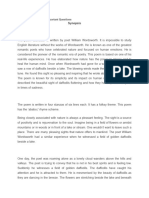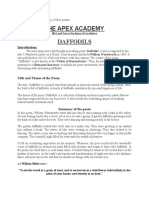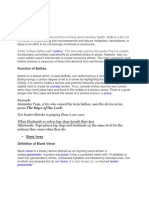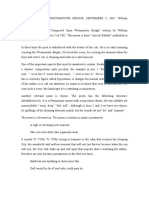Daffodils – Notes
By : Priyanka Upadhyay
_______________________________________________________________________
Introduction and Inspiration:
William Wordsworth's inspiration for writing the poem "Daffodils," also known as "I
Wandered Lonely as a Cloud," can be traced back to a specific incident and the profound
impact of nature on his sensibilities. In April 1802, Wordsworth took a walk with his sister,
Dorothy, in the Lake District of England. This particular excursion led him to a stunning
display of wild daffodils along the shores of Ullswater. The sight of this golden carpet of
flowers left an indelible impression on him, and it is this experience that inspired him to
write the poem.
Wordsworth was a central figure in the Romantic literary movement, which celebrated the
beauty and emotional power of the natural world. The encounter with the daffodils
resonated deeply with Wordsworth's belief in the transcendent and transformative
qualities of nature. He was moved by the sheer abundance and vividness of the scene,
where the daffodils appeared to dance in the breeze, creating a vision of timeless beauty.
Wordsworth's poetry often focused on moments of personal revelation and the emotional
impact of nature on the human soul. In "Daffodils," he saw an opportunity to capture the
profound sense of joy and solace that nature had bestowed upon him during that walk.
The poem became a reflection of his own emotional response to nature's beauty and an
exploration of the enduring connection between the natural world and the human spirit.
The poem's enduring appeal can be attributed to the way Wordsworth's personal
encounter with the daffodils is transformed into a universal experience. It encapsulates
the idea that moments of solitary reflection in nature can lead to a heightened sense of
emotional well-being and a deep connection to the natural world. Wordsworth's
inspiration, rooted in a specific event, serves as a testament to the power of nature to
inspire and uplift the human spirit, a message that continues to resonate with readers
today.
Modern Day relevance of the poem:
In modern times, William Wordsworth's poem "Daffodils" remains highly relevant as it
speaks to enduring aspects of the human experience that transcend historical and
technological changes. Its relevance can be seen in several ways:
1. Nature's Healing Power: In an era marked by increasing urbanization, technology, and
the constant demands of modern life, "Daffodils" serves as a poignant reminder of the
therapeutic and rejuvenating power of nature. As people grapple with stress, mental
health issues, and the detachment from the natural world, the poem underscores the
importance of reconnecting with nature to find solace and inspiration.
1
�2. Mental Wellbeing: The poem's emphasis on the emotional and psychological impact of
nature resonates strongly in today's world, where mental health and well-being are major
concerns. The idea that a simple encounter with nature can alleviate feelings of loneliness
and despair is a message that still holds true, encouraging individuals to seek solace and
perspective in the natural world.
3. Imagination and Creativity: In a time when technology often dominates our lives,
"Daffodils" underscores the power of the imagination to shape our perceptions and enrich
our experiences. In a digital age, where imagination can be overlooked, the poem
encourages us to appreciate the profound impact of the human mind in interpreting and
deriving meaning from the world around us.
4. Environmental Awareness: As environmental concerns become increasingly pressing,
Wordsworth's celebration of nature in "Daffodils" serves as a call to action. The poem
reminds us of the beauty and fragility of the natural world, encouraging modern readers to
engage in conservation and responsible environmental stewardship.
5. Timeless Emotions: The universal emotions of awe and transcendence evoked by the
poem remain timeless. Regardless of the era, readers can connect with the sense of
wonder and joy that nature's beauty can inspire, fostering an enduring emotional
connection with the poem.
In essence, "Daffodils" endures in modern times as a source of inspiration, a reminder of
the restorative power of nature, and a call to cherish the natural world. Its themes of
mental well-being, imagination, environmental awareness, and timeless emotions make it
a relevant and cherished work in an ever-evolving world.
Critical Appreciation and Themes:
"Daffodils" is one of William Wordsworth's most celebrated and enduring poems, and it
encapsulates the essence of his romantic philosophy, emphasizing the profound
connection between nature and human emotions. This poem is often referred to as "I
Wandered Lonely as a Cloud," which reflects the poet's deep sense of solitude and his
eventual encounter with a field of daffodils that lifts his spirits. This critical appreciation will
explore the themes, structure, language, and imagery in the poem, highlighting its
enduring appeal.
Themes:
1. Nature's Healing Power: Wordsworth believed in the therapeutic influence of nature on
the human soul. In "Daffodils," he illustrates how the simple sight of nature's beauty can
alleviate loneliness and melancholy, underscoring the idea that nature has the power to
uplift and rejuvenate the human spirit.
2. The Sublime: The poem touches on the sublime, a key element of Romanticism,
wherein the encounter with the daffodils and the natural landscape evokes a sense of
2
�awe and transcendence. Wordsworth's description of the scene conjures up a vivid image
that can evoke similar emotions in the reader.
3. Imagination: Wordsworth champions the power of the imagination and its ability to
shape human perception. In "Daffodils," the daffodils continue to provide solace even
after the immediate encounter, emphasizing the lasting impact of the imagination.
Structure:
"Daffodils" consists of four six-line stanzas, each following a regular ABABCC rhyme
scheme. The consistent structure serves to create a sense of harmony and balance in the
poem, mirroring the balance that the speaker finds in nature. Wordsworth's choice of a
lyrical ballad form is characteristic of his poetry, and it complements the contemplative
and meditative tone of the poem.
Language and Imagery:
Wordsworth's language is simple and accessible, aligning with his belief in the common
language of the people. The poem's diction and syntax are unadorned and natural,
reflecting the idea that profound truths can be expressed in everyday language.
The imagery in "Daffodils" is vivid and evocative. Wordsworth's description of the daffodils
as a "golden" crowd, dancing in the breeze, creates a vivid visual picture that captures the
reader's imagination. The dancing daffodils symbolize a joyful, carefree spirit, and their
continuous "fluttering and dancing" illustrates the eternal and timeless nature of the
scene.
Emotional Impact:
One of the poem's strengths is its emotional resonance. Wordsworth's portrayal of the
transformative effect of nature is something to which many readers can relate. The poem
conveys the idea that even in moments of solitude, the memory of nature's beauty can
bring solace and joy, leaving a lasting imprint on the mind and heart of the reader.
Enduring Appeal:
"Daffodils" endures as a beloved poem due to its universal themes and emotional depth.
The poem continues to inspire readers, reminding them of the beauty and power of the
natural world. Its accessibility and lyrical beauty make it a favorite choice for poetry
enthusiasts and educators alike.
In conclusion, "Daffodils" by William Wordsworth remains a masterpiece of English
Romantic poetry. It seamlessly combines the themes of nature's healing power, the
sublime, and the role of the imagination in a structured yet emotionally resonant form. Its
language and imagery continue to captivate readers, offering a timeless message of
solace, inspiration, and the enduring bond between nature and the human spirit.
Wordsworth's "Daffodils" stands as a testament to the enduring power of poetry to
capture the essence of human experience.
3





























































































